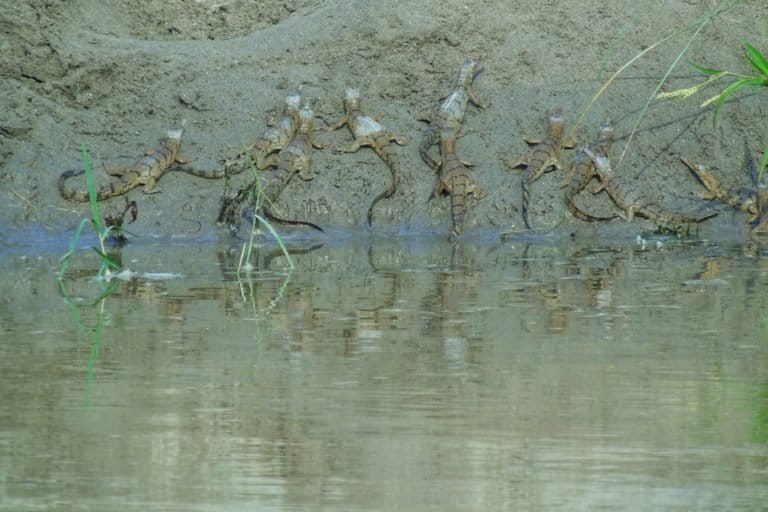- Throughout 2022, Mongabay reported on new species discoveries in Nepal, some of them new to science and others spotted for the first time in the country.
- From busting the Yeti myth to highlighting important biodiversity hotspots in need of conservation, the stories helped bring the Himalayan country’s little-known wildlife to a wider audience.
- These are the top six stories related to important scientific discoveries in Nepal this past year.
KATHMANDU — Throughout 2022, Mongabay reported on important biodiversity-related scientific discoveries in Nepal. The stories, some of them republished by different media outlets in Nepal and abroad, brought the country’s little-known by rich biodiversity to a wider audience, and shed light on crucial regions in the country awaiting conservation.
Here are some of the most significant stories from the past year:

It’s no Yeti, but Tibetan brown bear’s presence in Nepal is no longer a myth
A study offered the first clear photographic evidence of the presence of Tibetan brown bears (Ursus arctos pruinosus) in Nepal. The camera-trap images were taken in 2013, but the study around them was only recently published because researcher Madhu Chetri was busy with other studies on snow leopards. For Chetri, the photos put to rest folklore he heard from villagers 20 years earlier about a Yeti-like creature prowling Nepal’s Himalayan region. Other studies have also shown, through genetic analysis, that hair and other samples attributed to the Yeti come from bears.

Carnivore sightings highlight richness of Nepal’s Trans-Himalayan region
Scientists recorded images of the steppe polecat (Mustela eversmanii), Pallas’s cat (Otocolobus manul) and Eurasian lynx (Lynx lynx) in Nepal’s Trans-Himalayan region. This was the first time these species had been spotted outside the country’s protected areas, and the first confirmation that they occurred in the little-explored Trans-Himalayan region. The findings were released in a statement from Nepal’s Department of National Parks and Wildlife Conservation and Department of Forests and Soil Conservation; researchers say academic publications are forthcoming.

Enigmatic binturong photographed in Nepal for the first time
Residents in western Nepal’s Pokhara Valley captured the first known photos of a binturong, or bearcat (Arctictis binturong), in the country. The small cat-like mammal is found across much of East and Southeast Asia, and while eastern Nepal is also considered part of its range, its presence in the country had never been confirmed until now. Conservation officials were unable to examine the animal in person because it was released back into the wild by local authorities. The binturong is categorized as vulnerable on the IUCN Red List, with its global population thought to have declined by 30% over the past 18 years.

In Nepal, a turtle that rose from the dead makes another grand entrance
Researchers discovered a population of black softshell turtles (Nilssonia nigricans) in a wetland in southern Nepal, raising hopes for its conservation. The critically endangered species was previously thought to occur in only a handful of ponds in Bangladesh and India, and was so rare that it was briefly declared extinct in the wild in 2002. The new discovery adds to other recent findings of the black softshell turtle in the Brahmaputra River that runs through India and Bangladesh.
Experts say the wetland and river populations are less prone than the pond-confined ones to the threats of fungal infection and inbreeding, and can form the basis of an ecotourism industry benefiting locals.

First gharial hatchlings spotted in nearly two decades in Nepal’s Karnali River
Twenty-eight gharial hatchlings were spotted in a tributary of Nepal’s Karnali River, the first sign of successful nesting in this waterway in at least 16 years. The discovery by villagers living near Bardiya National Park came on June 15, two days before World Crocodile Day, and indicates the critically endangered species, Gavialis gangeticus, is on the road to recovery. Nepal is home to about 200 breeding gharials, and since 1978 has carried out conservation and breeding programs for the species.

An elusive lizard thought to live only in India makes an appearance in Nepal
Researchers confirmed the presence of the Sikkim grass lizard (Takydromus sikkimensis) in eastern Nepal, nearly 100 kilometers (60 miles) from its known range in India’s Sikkim state. The species was last year classified as endangered on the IUCN Red List because of its limited distribution and threats to its habitat from farming and a hydropower dam. Herpetologists say the discovery should prompt more research into Nepal’s little-studied reptile and amphibian life, with the potential for more species coming to light.
Banner image: Pits, some of them more than 2 meters (7 feet) deep — dug by the bears. Image courtesy of Madhu Chetri.
Crafting Nepal’s conservation success: Q&A with Sharad Chandra Adhikary
